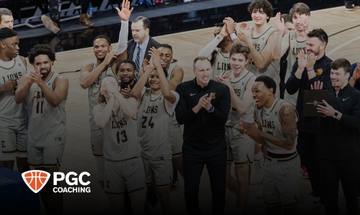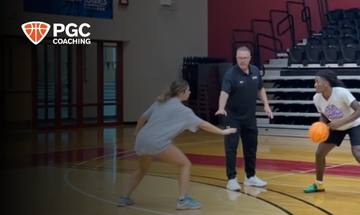How to Build a Winning Basketball Team Culture: 5 Daily Habits for Coaches
As coaches, most of us want the same things…
…players who are tough, who communicate, who play with energy and connection. We want to build a winning basketball team culture. But in most cases, those intangibles are left to chance.
Here’s what I mean…
If you’re not teaching, tracking, or talking about them consistently, then you’re probably not getting them—at least not in a way that lasts when pressure hits.
So before we dive into how you can avoid that, I want to share some additional resources you may want to check out after you learn how to build a winning basketball team culture:
- 7 Ways to Build a Winning Culture in Your Basketball Program
- Embrace Adversity: Turning Tough Losses Into Opportunities
- How to Execute a Great Basketball Practice
Anyways, back to the question you should be asking yourself…
How can you develop the intangibles in a practical, daily way without sacrificing skill, strategy, or time?
It starts with two things:
- A clear framework for what you value
- Tangible tools your players can act on every day
At PGC, our framework is simple; it’s called SCHAPE:
- S – Spirit
- C – Communication
- H – Hustle
- A – Attitude
- P – Precision
- E – Enhancement
This acronym gives us a way to talk about the intangibles clearly and consistently.
But the magic isn’t just in the language—it’s in what we do with it.
So let’s walk through five ways to bring SCHAPE to life in your gym and use it to build a winning basketball team culture.
1. Make Standards Visible
Small changes create big basketball team culture shifts. Here’s an example…
At the beginning of one season at Emmanuel, we added a simple rule: All high-fives must be above the shoulders.
That’s it.
But that one tweak changed the tone of our entire gym. Suddenly, every interaction became intentional. Players looked each other in the eye. And they brought energy and connection. Their actions communicated: “I see you. I’ve got your back.”
Here’s an easy way to try this in your gym:
- Set a goal: 30 high-fives per practice
- Track it: Have a manager tally it or let players self-report
- Celebrate it: Shout out the players who initiate the most connection
Remember, what’s visible becomes valuable.
2. Give Players a Role in Culture
Most players aren’t resistant to your basketball team culture values—they’re just unsure how to live them out.
They want to bring energy…
They want to encourage teammates…
They want to contribute to something bigger…
…But without a clear path, they default to either doing nothing or following the loudest voices on the team.
That’s where clear, trackable roles come in.
When players know exactly how they can contribute to the team’s basketball culture—and that their contribution matters—it unlocks two powerful outcomes:
- Ownership – They start to feel responsible for the energy, not just affected by it.
- Intentionality – Their actions become purposeful instead of passive.
And when that happens, basketball team culture stops being coach-led and starts being player-driven.
3. Define What You Want to See
You can’t expect what you haven’t defined.
Most coaches say they want “toughness,” “effort,” and “unselfishness”…
But if you asked your players, “What does toughness look like on the court?”—would they know how to answer?
Basketball team culture breaks down in the gap between what you expect and what players understand… unless you define the behaviors that reflect your values.
At Emmanuel, we use Jay Bilas’ “Toughness” article as a teaching tool. Instead of preaching toughness, we teach what it looks like in action.
Here’s how:
- We print out the key points of the article—things like:
- “Tough players talk on defense.”
- “Tough players take charges.”
- “Tough players set solid screens.”
- We assign a few examples to each player.
- Then, we have them present those examples back to the team.
Now, players not only know what toughness sounds like—they know what it looks like.
And at this point, we have a shared language we can use to reinforce these behaviors.
Because at the end of the day, you get what you praise.
So if you want to see more toughness and effort, start praising them by name, out loud, in front of the group.
4. Explain the Why Behind Your Standards
If you want deeper buy-in from your players, teach them the why behind the what.
Take standing and clapping when a teammate subs out, for example…
Do your players know why they’re doing it?
If they don’t, they’re just going through the motions. It’s noise without meaning. And meaningless habits don’t build a strong culture.
Here’s how it could be explained to be the why in the equation:
“We stand and clap because it’s a sign of respect. We do it because it shows unity and it reminds every player that we’re in this together.”
That explanation transforms a routine into a ritual. And rituals shape the identity of your team.
When players know the why, they don’t just follow your standards—they believe in them.
And belief is what fuels consistency.
5. Fight for It Daily
Here’s the hard truth: Basketball team culture doesn’t happen by accident. It happens by design—and through repetition.
Most coaches miss the mark because they don’t make it practical, and they don’t pursue it daily.
The good news?
You don’t need a complicated system—you just need a consistent one.
Here’s a daily checklist to build and reinforce your culture:
- Define what you value
- Equip players to live it
- Track it, celebrate it, and talk about it—every day
FAQ: Building a Winning Basketball Team Culture
Q: What is the SCHAPE framework in basketball coaching?
A: SCHAPE is an acronym used by PGC Basketball to teach and reinforce essential team culture values: Spirit, Communication, Hustle, Attitude, Precision, and Enhancement. These are the intangibles that drive connection, accountability, and performance. It gives coaches and players a shared language to intentionally build a winning basketball culture.
Try highlighting one letter of SCHAPE each week in practice to make cultural habits stick over time.
Q: How do I create visible standards that improve team culture?
A: Simple, trackable habits like above-the-shoulder high-fives or tallying acts of encouragement can elevate practice energy. When culture is visible (and celebrated), players internalize it. Visibility turns intangible ideas into behaviors you can recognize and repeat.
Pick one daily culture behavior to measure and shout out—and watch your team’s connection grow.
Q: How can I give my players ownership of our team culture?
A: Assign culture roles like “energy captains” or “communication anchors.” When players are responsible for upholding team values, they shift from passive participants to active culture-builders. The more ownership they take, the less you’ll have to micromanage.
Designate weekly player-led roles to drive culture from within—because peer leadership is power.
Q: What are practical ways to teach toughness to my basketball team?
A: Use resources like Jay Bilas’ Toughness article to define what toughness looks like in action. Have players present examples like “take a charge” or “set a great screen.” When players understand tangible behaviors, they can actually live them out on the floor.
Start each week with a “Toughness Example” spotlight and challenge your team to model it in drills.
Q: Why is explaining the ‘why’ behind team habits so important?
A: Explaining the why behind cultural habits—like standing when a teammate subs out—creates meaningful rituals, not mindless routines. Understanding the deeper purpose helps players buy in emotionally, making your standards stick even under pressure.
Next time you introduce a habit, pair it with a purpose to build belief—not just compliance.
Q: How can I reinforce team culture without taking time away from skill development?
A: Layer cultural reinforcement into existing drills. For example, track “SCHAPE points” during 5-on-5 scrimmages or celebrate communication during defensive slides. It’s not extra time—it’s intentional time that amplifies your skill work with purpose.
Blend culture-building with drills by spotlighting energy, communication, and effort every rep.
Q: What’s one habit I can start tomorrow to build a better basketball culture?
A: Start each practice with a 60-second “culture check-in.” Ask players who encouraged a teammate yesterday, or who set the tone with energy. Small reflections like this reinforce habits and connect values to action.
Try one culture question at the start of practice and let players take the lead in setting the tone.
Q: How do you make basketball culture stick throughout the entire season?
A: Consistency beats intensity. Don’t wait for special team meetings or big speeches. Instead, make your cultural language (like SCHAPE) part of daily conversations, practice plans, and player feedback. The teams with lasting cultures don’t just talk about it—they live it.
Post SCHAPE on your wall, reference it every day, and model it relentlessly—it becomes who you are.
Q: What are examples of basketball culture habits that win games?
A: Habits like “talk early and often,” “sprint to pick up a teammate,” or “celebrate the screen assist” win close games. These don’t show up on the stat sheet—but they build trust, momentum, and unity under pressure.
Pick three game-winning habits to emphasize this week—and reward them like points on the scoreboard.
Q: Where can I get more support and ideas for building team culture as a coach?
A: Inside the PGC Coaching Community, you’ll find a network of like-minded coaches, plus access to exclusive tools, drills, and culture frameworks designed to help you build a connected, competitive team.
Want to build a culture that lasts? Join the PGC Coaching Community and grow with other committed leaders.
If you want a team that plays with energy, toughness, and connection—Don’t leave it to chance.
Put the tangible to the intangible.
Make it real.
Make it visible.
Make it daily.
And above all—model it yourself.
Culture doesn’t just show up—it’s built, day by day, habit by habit. Whether you’re working with youth, high school, or college athletes, make the invisible visible. Teach it, track it, celebrate it. And when you’re ready to take it further, we’ve got a coaching community ready to support your journey.
If you’d like to explore even more resources just like this, grab a free 7-day trial to get access to our members-only content.
TJ
Check more practice transformational coaching fundamentals here.
About the Author
TJ Rosene
Coach TJ Rosene, head coach of the Emmanuel University men’s basketball team and Director of Coach Development for PGC Coaching, has spent his career shaping young athletes both on and off the court. With over 400 career wins and 12 seasons of 20+ wins, Rosene’s coaching experience is extensive and impressive. His teams have competed in six national championship games, winning three NCCAA National Championships. Under his leadership, the Lions made their NCAA Division II debut in 2018-19 and quickly captured two season titles and one tournament title, along with an appearance in the NCAA Division II Sweet 16 in 2021./p>
Rosene’s success expands far beyond the scoreboard. He’s been named National Coach of the Year three times and Conference Carolinas Coach of the Year twice. But for Coach Rosene, the most meaningful part of his work is the lasting impact he has on his players’ lives. As he puts it, “Coaching is a rare opportunity to shape and mold the lives of young people. It’s a privilege that I never take for granted.”
New Here?
Get coaching tips and tools like these delivered to your inbox each week!
Join the 15,000 coaches we’ve assisted…

Related Articles
Embrace Adversity: Turning Tough Losses Into Opportunities
Turn tough losses into wins. Learn how DEFTH helps coaches lead through adversity and build unstoppable teams.
7 Ways to Build a Winning Culture in Your Basketball Program
Winning teams don’t happen by accident. Learn 7 powerful culture-building principles top programs use to stay tough, united, and built to last.
How to Build Basketball Shooting Consistency: The Missing Feedback Every Coach Needs
Discover why players shoot well in practice but not in games, and how measurable shot feedback can fix it. Learn simple ways to add clarity, improve consistency, and use tools like Noah Basketball to turn practice reps into real, game-time results.
About PGC
PGC Basketball provides intense, no-nonsense basketball training for players and coaches. Our basketball camps are designed to teach players of all positions to play smart basketball, be coaches on the court, and be leaders in practices, games and in everyday life.
We combine our unique PGC culture with a variety of teaching methods and learning environments to maximize the learning potential of those that attend our sessions. In addition to spending 6-7 hours on the court each day, lessons will be reinforced through classroom sessions and video analysis.
Our goal at PGC is to empower you with the tools to fulfill your basketball dreams, while also assisting you in experiencing the joy of the journey.
To learn more about PGC Basketball, including additional basketball training tips and videos, visit our YouTube Channel or find us on Facebook, Instagram, and Twitter.






Share This Post